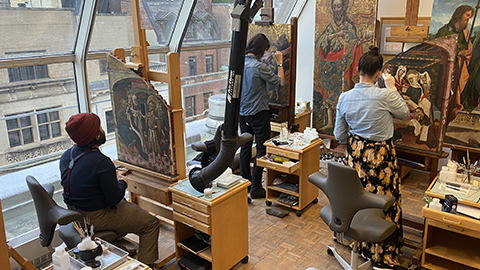From Polyptych to Easel Painting: A Panel from A Dismembered Altarpiece by Giusto De’Menabuoi
by Hae Min Park
Annual ANAGPIC Conference, April 5-7, 2018, hosted by Queen’s University
Abstract
The Terzago polyptych is one of the rare tempera on panel commissions Giusto de’Menabuoi completed in or near Milan before he became a renowned fresco painter in Padua. The polyptych has been dismantled since an unknown date and only fourteen fragments have been securely identified, five of which now form a part of the Samuel H. Kress Collection at the Georgia Museum of Art, Athens. As these five panels went through the hands of various collectors, they were altered with an intention to present them as stand-alone easel paintings, drastically impacting several 20th Century interpretations of the polyptych. A recent examination of the five panels, specifically the punchmarks and barbed edges that had been concealed under fill and overpaint, revealed new evidence for a heptaptych configuration of the altarpiece. Based on these findings, I will outline the inaccuracies in the past reconstructions and illustrate the conservators’ potential capacity to radically influence the function and meaning of an artwork. Furthermore, I will also discuss the treatment of the best-preserved panel of the series, which presented an interesting challenge. Underneath the thick layers of discolored varnish and overpaint, dark gray encrustations marred the painted passages of Saint Paul and Saint Augustine. These deposits, remnants of old retouches or coating, had chemically bonded to the painted surface and disrupted the refined gradation of vivid and delicate colors. While it was possible to mechanically remove larger deposits under the stereomicroscope, the remaining deposits were optically scumbled using dry pigments in PVA AYAB resin dissolved in ethanol.






